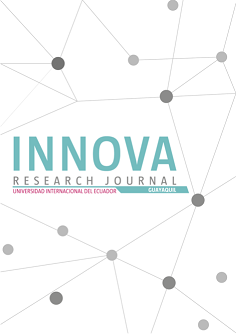Análisis de la influencia de la economía digital en el desarrollo de la competitividad de las empresas que utilizan las redes sociales en el Ecuador -Caso RC Business S.A.
Main Article Content
Abstract
Competitiveness for a company translates into the ability of companies to have assets such as the innovative capacity they possess to generate new products and production processes (Porter, 2015). Thus, it is identified that social networks are related to competitiveness indices in Ecuador (Ochoa, 2016), which leads to analyze in this study that aims to determine the impact of Social Media on the competitiveness of companies from the analysis of a management model.
In this case, it has been considered appropriate to relate the Canvas model due to the variables it presents, including: value proposal, relationship with customers, key partners, activities and key resources, cost structure and income budgets.
The methodology used was carried out through a bibliographic study that allows analyzing the most representative competitiveness model. So also, statistics of the sector that allow to identify under an objective criterion the model to be selected justifying by means of the application in a case of business study.
Keywords: competitiveness, social media, value proposal.
Downloads
Article Details
COPYRIGHT NOTICE
Authors who publish in the INNOVA Research Journal keeps copyright and guarantee the journal the right to be the first publication of the work under the Creative Commons License, Attribution-Non-Commercial 4.0 International (CC BY-NC 4.0). They can be copied, used, disseminated, transmitted and publicly exhibited, provided that: a) the authorship and original source of their publication (magazine, publisher, URL and DOI of the work) is cited; b) are not used for commercial purposes; c) the existence and specifications of this license of use are mentioned.
References
ACR. (8 de 11 de 2016). Diario El Mercurio. Emprendimiento que se mueve vía redes sociales, pág.1.
Aguirre, G., & Andrade, H. (2006). Guayaquil: Repositorio Espol.
Baena, E., & Sánchez, J. (2003). El entorno empresarial y la teoría de las cinco fuerzas competitivas. Scientia et technica, 5.
Bonales, J., & Zamora, A. (2015). Variables e índices de Competitividad de las empresas exportadoras, utilizando el PLS. CIMEXUS Vol. X, No. 2, 20.
Crespo, P. (2013). El uso de las TICS como herramienta para la internacionalización de las PYMES en el Ecuador.Cuenca: Repositorio Universidad del Azuay.
Ferraro, C. (2010). Políticas de apoyo a las pymes en América Latina.Santiago de Chile: CEPAL.
Ochoa. (1 de Junio de 2016). Diario El Universo. Ecuador es el segundo país que más emprende en el mundo, pero los negocios no se consolidan, pág. 1.
Orozco, M., & Quiroz, G. (19 de Julio de 2015). Diario el Comercio. El 82% de pymes de Ecuador accede a Internet, pero su uso se limita a enviar correos y tareas administrativas, pág. 1.
Pfeilstetter, R. (2011). Elemprendedor. Una reflexión crítica sobre usos y significados actuales de un concepto. Gazeta de Antropología, 15.
Pico, L., & Coello, R. (2017). Relación entre el ciclo de vida de las Pymes en redes sociales y el emprendimiento en la ciudad de Guayaquil.I NNOVA Research Journal, 18.
Porter, M. (2015). Ventaja Competitiva. Creación y sostenimiento de un desempeño superior.México: Grupo editorial PATRIA S.A. 2da. edición reformada.
Vainrub, R. (2009). Una guía para emprendedores.Ciudad de México: Pearson.






